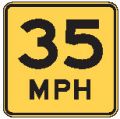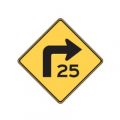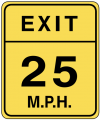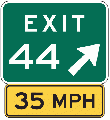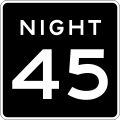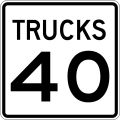Speed Limits
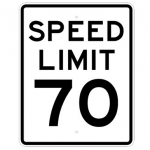
Speed limit data added to segments in the WME is used in the Waze app to display an app user's speed relative to the speed limit. In addition, the app notifies users if they exceed a speed limit designated on the Waze map.
The ONLY speed limits added to the map must match federal, state, and municipal laws or regulations that designate maximum speeds for passenger vehicles.
| WORK ZONES: Speed limits in work zones are often lowered to protect workers and prevent collisions. If these speed limits appear on the regulatory blank and white signs, they COULD be added to the associated WME road segments. However, this should be done in consultation with State Managers, so that the temporary speed limits can be monitored for changes. |
Any highway ramp with speed limits posted on the regulatory black and white signs should be added to the road segments in the WME. Ramps with advisory speed signs, as shown below, should have no speed limit in the WME.
Speed limits that are designated on private property may be added to road segments on the Waze map at the discretion of regional or state managers.
| Speed Limits are added to parking lot and private road types by changing type to street, adding limits, then reverting to the original road type. |
Variable Speed Limits
The WME and Waze app do not support Variable Speed Limits (VSLs) that are changed based on traffic and road conditions. These VSLs can be changed at any time by government officials. If there is a 'standard' speed limit at which the signs on a stretch of road are usually set, this 'standard' speed COULD BE added to the associated road segments in the WME. However, the setting of any speed limit on a road with VSLs must be done in consultation with the appropriate State Manager.

Unsupported Speed Limits
The following speed limits are unsupported by the WME and the Waze app, and MUST NOT be added to road segments in the WME. Road segments with posted 'advisory' speeds or special speed limits should continue the Speed Limit for passenger vehicles as posted on the black and white signs pictured above.
Advisory Speed Limits
In addition, yellow 'advisory' speed signs (as shown below) are usually not enforceable; therefore, 'advisory' speeds, like the ones shown below, should NOT be added to the waze map.
-
Advisory Plaque
-
Turn Advisory
-
Exit Advisory
-
Exit Sign Plaque
Special Speed Limits
As of February 2016[update], the WME and Waze App only support maximum speed limits for passenger vehicles, without variation for time of day, or day of the week. Specialty, also known as 'bannered', speed limits, like the ones shown below, should NOT be added to the Waze map.
-
Night Speed
-
Truck Speed
-
School Speed
-
Minimum Speed
| School zone speed limits that are in effect 24 hrs per day, and 365 days a year, should be added to the map. |
TBD
How far from an existing junction not to a new a cut. No advisory limits. Ramps may have limits if there's a black and white sign. Same for AGCs, though many AGCs can inherit the SL of the segment which feeds into them. How you want to deal with work zone limits, (perhaps only adding them if they're anticipated to last more than X months, etc). Another work zone option is adding the base SL now, and leaving the WZ SL as a NOTE mph UR My interim guidance in NY until the feature goes live to production has been only add WZ SLs if they are anticipated to persist more than a year, otherwise add the regular SL, and the WZ SL as a note. Once it goes live I'd support adding WZ SLs which are expected to last at least 3 months. My rationale is I don't want to add WZ SLs now and have to remove them again before the feature is even published.
Basically I see three types of AGCs
1) extra segments we add to the map for ETA or prompt control which are essentially just us mapping a specific lane of the road. these typically terminate at the intersection, and can be considered a part of the road they are on.
>These would share the same SL as the segment they are coming from/run parallel with.(s-in)
2) segments that functionally are ramps which for some reason are not using the ramp type, these are median separated from the regular road, and includes accel/deceleration type lanes.
We can treat these just as ramps
>>If the SL is different before and after the AGC is the same; use that.
>>If there is a posted regulation SL for the AGC; use that.
>>If the SL before and after is different, and there is no sign, we can leave these blank.
3) Actual strips of road physically connecting different streets. Like triangle intersections these may or may not be named streets. With these I believe they would legally follow the SL of the segment leading into them since the SL is applied until you enter a new zone which supercedes them. So until you traverse the AGC to the new road where a new SL is in place you are still bound by the previous SL
This can be simplified into 3 basic rules for AGCs in this order of preference (apply first match)
1) if it has its own dedicated posted regulation SL, use it.
2) If the SL before and after are the same, use it
3) If it looks and functions as a ramp, leave it blank, otherwise use the SL of the segment feeding into the AGC (s-in)
